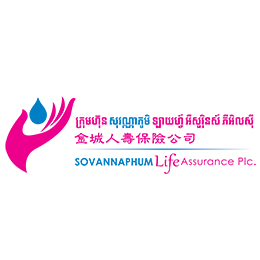December 2022
Sovannaphum Life Assurance offers products and services to help Cambodians protect themselves and their families
Sovannaphum Life Assurance: "Here for You, Here for Cambodia"
Sovannaphum Life Assurance understands the challenges Cambodia faces as it transitions to a middle-class country and is prepared to assist by offering products and services that help Cambodians protect themselves and the families who depend on them for financial support.
In July 2022, the Khmer Times reported that the insurance industry in Cambodia has grown about 20% annually for the last five years – despite the COVID-19 pandemic.1
According to the Word Bank, between 1998 to 2019, Cambodia's economy grew at an average annual rate of 7.7 percent, making it one of the world's fastest growing economies. And poverty rates declined by 1.6 percentage points a year from 2009-2019, mostly due to an increase in the number of wage earners. This is in large part a result of the increasing industrial sector and the decline of agriculture as a driver of Cambodia's GDP and employment.2
Cambodia has emerged as one of the fastest growing economies in ASEAN for almost a decade (pre-COVID), which has resulted in its fledgling insurance sector showing remarkable growth. According to the Insurance Association of Cambodia, the country's total gross premiums have increased at an average of 35% annually for the past five years.3
Having reached lower middle-income status in 2015, Cambodia set its sights on attaining upper middle-income status by 2030 and has an emerging middle class making considerable strides in improving its standard of living and quality of life.4
"There are also many young Cambodians with a higher education that are aware of the importance of insurance and the need for future financial planning to protect them and their families from unfortunate life events," said Sovannaphum Life CEO Kah Meng.5
Kah Meng, a veteran in the insurance industry, advised that Sovannaphum Life (SVL) is actively embracing digital technology to benefit its customers.
As part of its digital transformation strategy, SVL has launched the "U Smile System" – a proprietary digital submission platform designed to reduce the turnaround times for insurance policies and to align with market trends.
SVL is also maximizing its reach to Cambodia's younger generation via Facebook and other digital media platforms.
Due to its strong and reliable financial base, London-based Global Banking and Finance Review ranked SVL as the fastest-growing life insurance company in Cambodia for four consecutive years – 2018, 2019, 2020, and 2021.6
"Being in a people-centric business, the company believes in listening to its customers. SVL hopes to further strengthen its commitment to providing peace of mind and protecting family finances throughout Cambodia by reestablishing its "Here for you, Here for Cambodia" brand promise," said Kah Meng.
The purpose of employee benefits is to provide economic security to workers, which in turn, improves employee retention across the organization.
SVL develops products and services to fulfill the specific needs of Cambodian customers, including group benefits.
It currently offers two primary group products:
- Group life insurance, which includes:
- Death benefit
- Disability insurance TPD rider
- Hospital daily benefit rider
Critical illness cost protection rider
- Group life accident protection, which includes:
- Accident death benefit
- Dismemberment, or loss of eyesight, hearing or speech benefit
- Total Permanent Disability benefit (TPD) caused by accidents
- Medical expense benefit – can be added as a possible rider
All group coverages listed above can be included in an IGP International Account.
Social security in Cambodia
The National Social Security Fund (NSSF) is a public institution established in 2007 to ensure the wellness and basic income security of private-sector workers in Cambodia. The NSSF registers members, collects contributions, manages NSSF finances, and implements and provides benefits to employees or beneficiaries.
Until recently, benefits covered by NSSF consisted of an occupational risk scheme that provides benefits in the event of work injury, commuting accidents and occupational diseases; and a health care scheme to provide preventive care, medical services and a daily allowance in case of medical treatment or other non-occupational accidents and maternity leave.
New NSSF pension scheme
In 2021, a new private-sector pension plan was launched, and effective October 1, 2022, enrollment was automatic for all employers and employees participating in the NSSF for health and accident coverage.
Details of the New NSSF pension scheme:
- All workers who are employed at private-sector firms are required to participate in the scheme, and employers had to register their employees within 30 days of the effective date.
- Employees younger than age 60 and not already covered on a mandatory basis can participate voluntarily.
- Although, employers pay 100% of premiums for the occupational accident and health care schemes, both employers and employees are required to pay 2% of covered monthly earnings/payroll up to a cap of KHR 1,200,000 for the pension scheme.
- After five years, the total contribution will increase to 8% and then after ten years, to 10.75%. Then, after each 10-year period, the total contribution will increase by 2.75%.
- Covered employees will be able to pay additional contributions on a voluntary basis for a higher benefit.
- When an employee reaches the age of 60, the NSSF calculates their pension based on their last six months of salary. The employee's covered earnings and a predetermined benefit amount are used for the calculation.
- If an employee dies before the age of 60, his or her family will receive the pension for one year.
- To receive pension benefits, an employee must have registered with the NSSF, be at least 60 years of age and made contributions to the pension scheme for at least 12 months. If someone has not contributed for at least 12 months, they can receive an old-age allowance instead of the pension.
- There is a monthly disability pension for insured persons who have at least 5 years of contributions and are not able to work because of a disability. The minimum disability pension is 45 percent of the insured’s covered earnings.
- A survivor pension is available for eligible dependents of a deceased person who was an old-age or disability pensioner or had at least 5 years of contributions.
Typical employee benefits in Cambodia
Group personal accident
- Death
- Permanent disability
- Dismemberment & loss of sight
- Medical Expense
Group hospitalization and surgical insurance
- Hospital room & board
- Intensive care unit
- Hospital supplies & service
- Surgical fees
- Operating theatre fees
- In-hospital physician fees
- Pre-hospitalization diagnostic services
- Pre-hospitalization specialist fees
- Follow-up medical treatment & services
- Emergency accidental outpatient treatment
- Government hospital daily cash allowance
Group life benefits
- Death
- Permanent and total disability
- Hospital daily benefit
- Group critical illnesses
Sovannaphum Life Assurance Plc:
Sovannaphum Life Assurance Plc. (SVL) is a joint-venture company between Canadia Investment Holding PLC., the holding Company of Canadia Bank, and Muang Thai Life Assurance PCL. Sovannaphum Life Assurance Plc. was granted full license as a life insurance company by the Ministry of Economy and Finance on December 24, 2015, and started operations in 2016.
With strong support from both shareholders, plus the use of “customer centricity” to understand the behavior of Cambodian customers, SVL develops the right products and services to fulfill their specific needs.
Why partner with Sovannaphum Life Assurance Plc.?
Learn more about the advantages of partnering with Sovannaphum Life Assurance Plc., view their key figures, recent awards and recognitions and get in touch with the local IGP contact.
Learn more

